
 |
|
|
|
#1
|
|||
|
|||
|
Saw the post your guns thread and thought you might enjoy some pictures of some of the rarer or more interesting guns from my collection of military small arms. First up, handguns.
 This is a Webley & Scott Model 1910 in .38ACP (or .38 High Velocity as it was known in Britain at the time). Webley & Scott of course made the break-action Webley revolvers used by the British Army, but also made a series of quite good automatic pistols. These were unique in that they actually had an enormously strong V-shaped mainspring in the left side of the grip rather than a conventional coil spring. The Model 1910 was designed in hopes of a military contract, but never got one, and was dropped from production in favor of the .455 calibre Model 1913 which would be adopted by the Royal Navy and the Royal Horse Artillery. This is one of less than 1000 made. 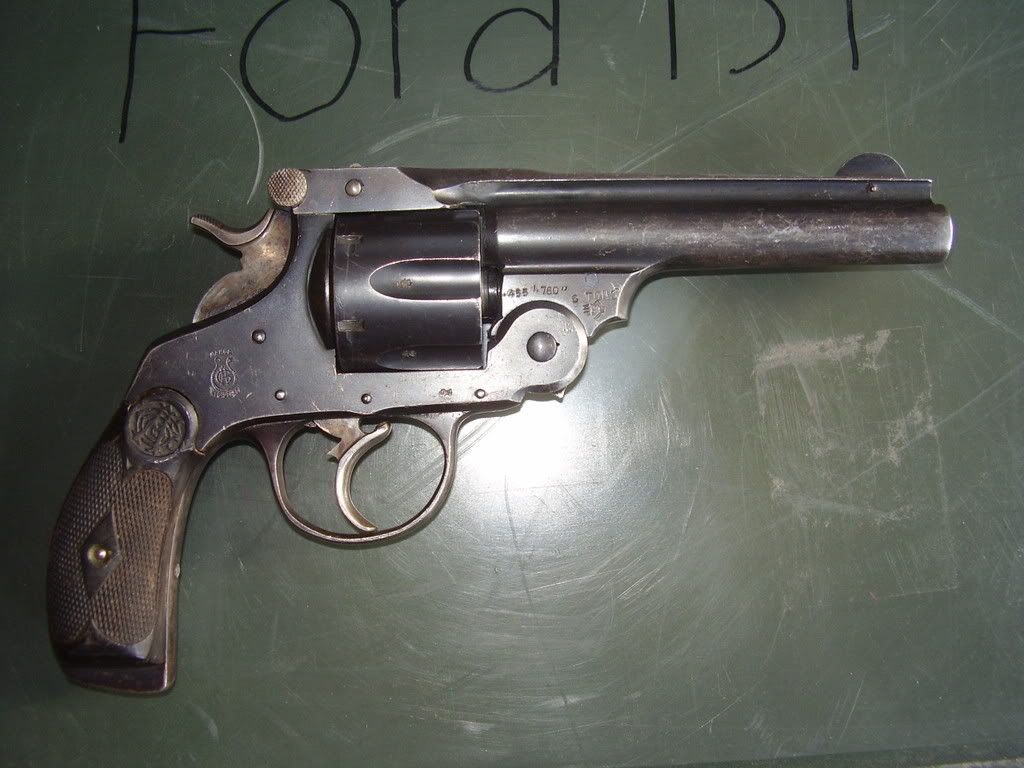 This is British army issued Garate Old Pattern No.2 Mk.I revolver, made in Spain. Spain has a long history of making (often parent infringing) firearms of various levels of quality. Because of their neutrality in WW1, they were a huge source of substitute standard handguns for the Entente, including these copies of the Smith & Wesson 1884 Frontier Double Action in .455 Webley calibre. They weren't very well-made and overshadowed by the Colt and S&W revolvers purchased in droves, and of course the standard issue Webleys. 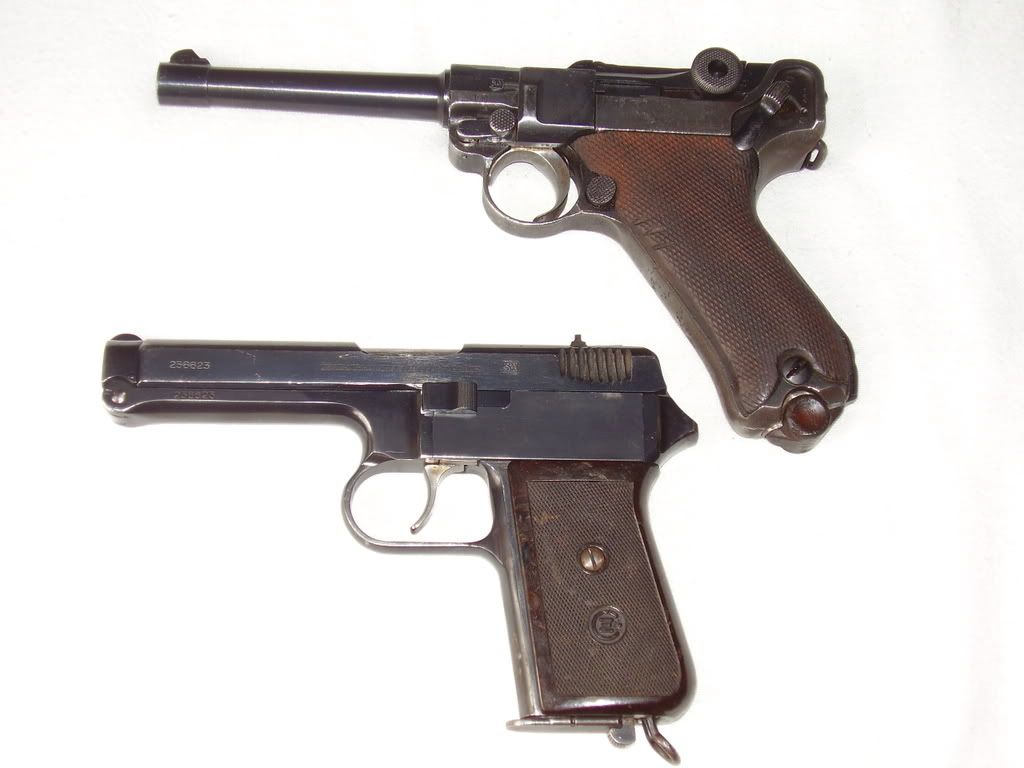 These are a pair of WW2 Finnish service pistols. The top one is a Luger M/23 with a Finnish-made 4 3/4" barrel in 9mm. Originally purchased in 7.65mm Luger calibre and with 3.9" barrels (because of limits on Germans arms manufacture imposed by the Treaty of Versailles), they were rebarelled during the 1941-1944 Continuation War with the Soviets to better match the Lahti L-35 that had replaced them. The bottom one is a Czech-made CZ-38 in .380 purchased from the Germans by the Finns during the Continuation War. It's a unique design, in that in spite of having an external hammer it's double action only, and strips simply by pressing the catch on the frame and lifting off the slide - it has a captive mainspring and the barrel is hinged to the frame. Handles really poorly, but it's surprisingly accurate. 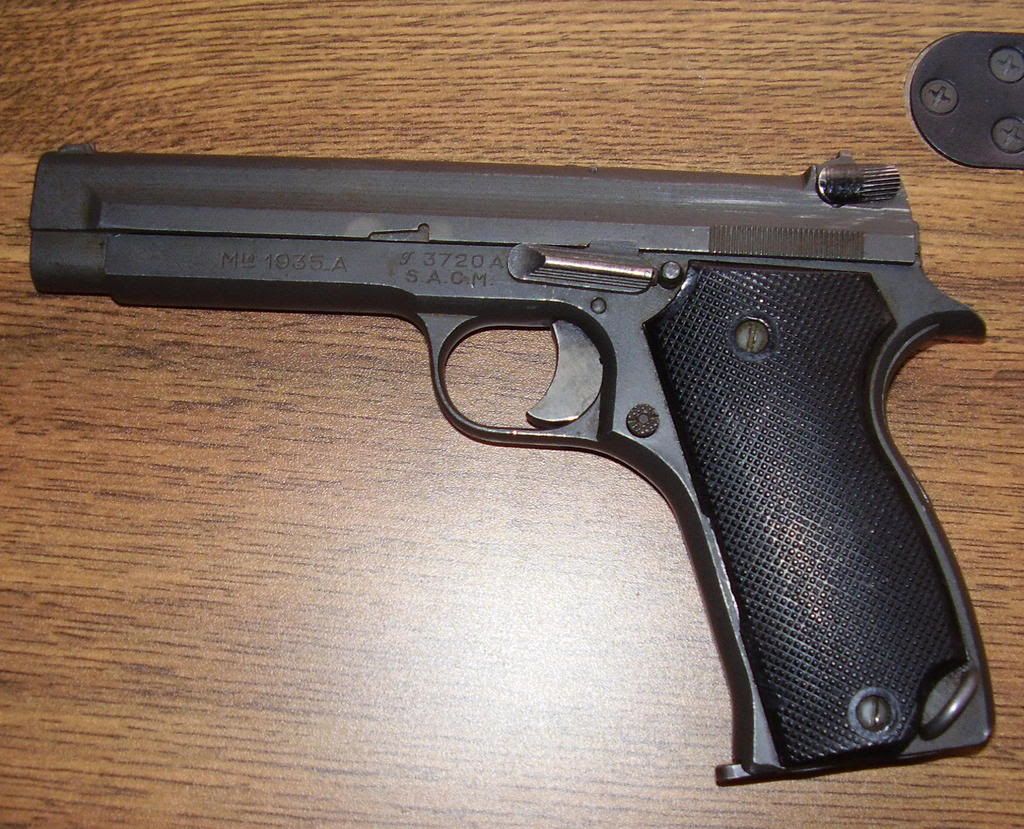 This is a French SACM mle. 1935A in 7.65mm Longue. It's basically a modified 1911 updated by Swiss firearms designer Charles Petter - who would go onto design the famed Sig P210 pistol, which has very similar lines to this. It fits the hand like a glove and points naturally, however it fires an underpowered cartridge and has one of the strangest locations for a safety I've seen. As an aside of trivia, thanks to the bureaucratic hiccup this is the only .32 calibre pistol in Canada that can be purchased on a standard handgun liscense. |
|
#2
|
|||
|
|||
|
More handguns!
 This is a Japanese Nambu T-14, made in 1941 by Nagoya arsenal. This one has the "Manchurian" triggerguard introduced later in production to allow it to be fired wearing heavy gloves, which proved necessary for troops deployed, you guessed it, in Manchuria. In spite of looking similar to the Luger, there's no mechanical similarity - if anything, it works along the same broad principles as the Mauser C/96. 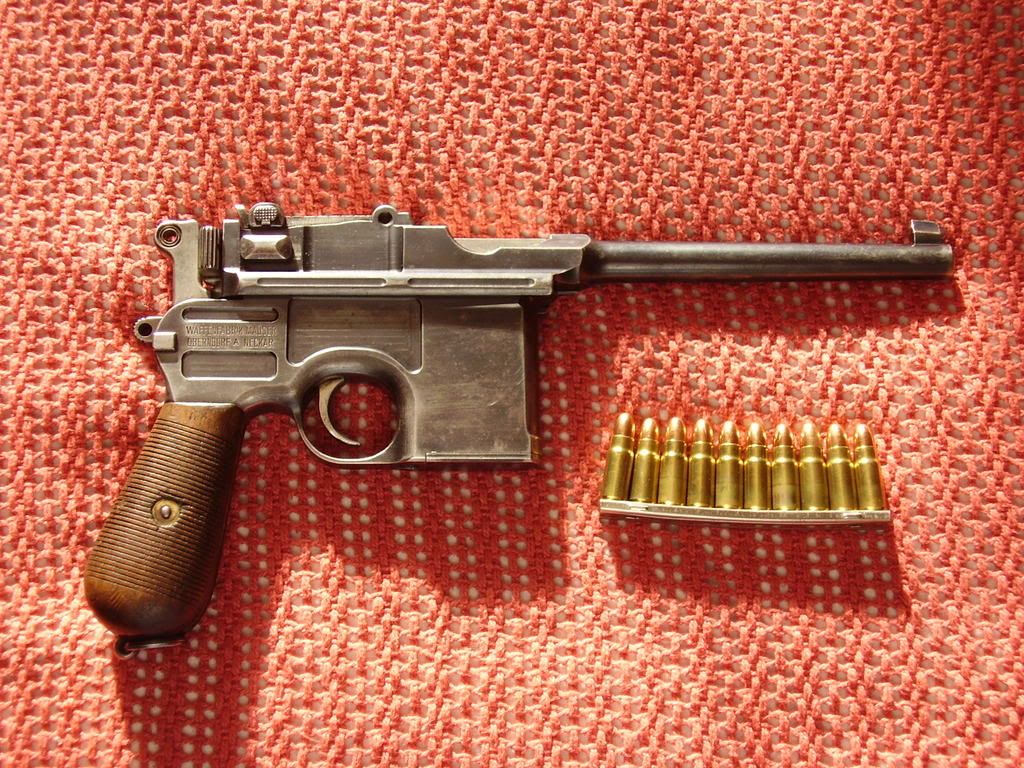 Speaking of the Mauser C/96, here's mine. it's the version known to collectors as a "Prewar Commercial", it was made in 1905, at the beginning of stable production - it actually took them about 10 years to settle on which features they wanted to include in these pistols and start making them in quantity. This one is all-matching and in nice shape, I replaced the worn-out mainspring so I could shoot it and kept the original. These are remarkable pistols, if you ever strip one they're like a Swiss watch on the inside. 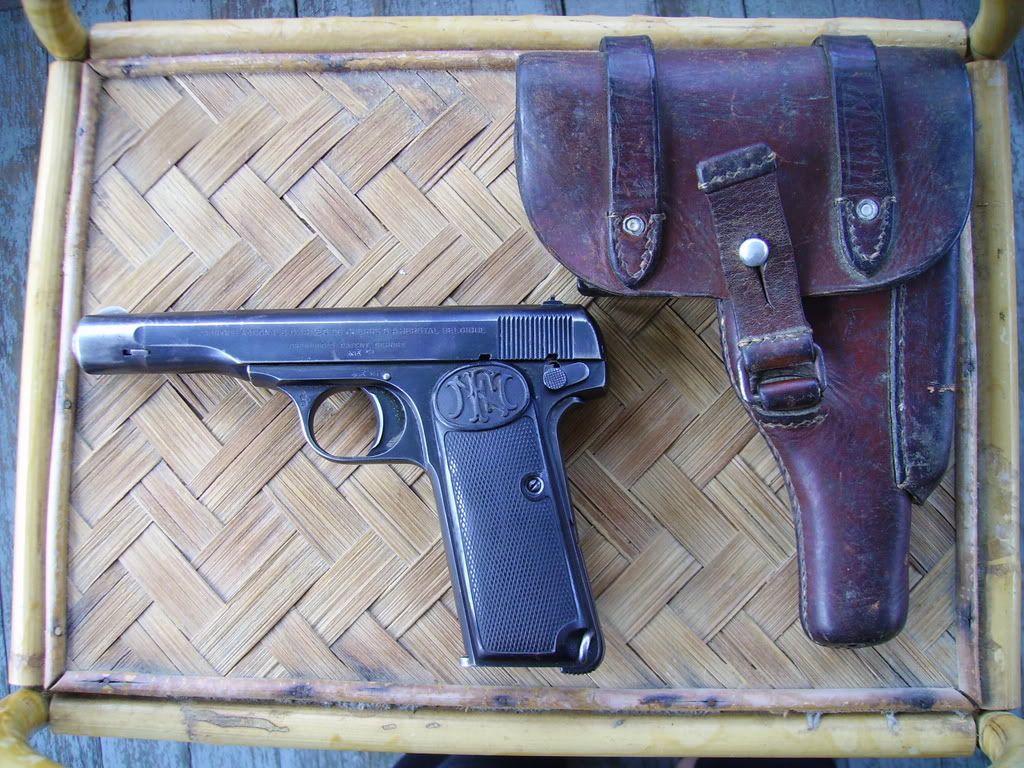 This is a Yugoslavian-issued Browning 1922 in .380. These are actually stretched versions of the Model 1910 pocket pistol with a lengthened slide and frame as requested by the Yugoslavs, between the wars these would be purchased by most of the minor powers in Europe. These were widely used by the Yugoslavian partisans during WW2. The Yugoslavian Brownings come in two models, the standard troopers model and the private purchase officer's model. This is the much rarer officer's model - no one knows exactly how many were made, but many Browning collectors have never even seen one. Mine came with the original holster. 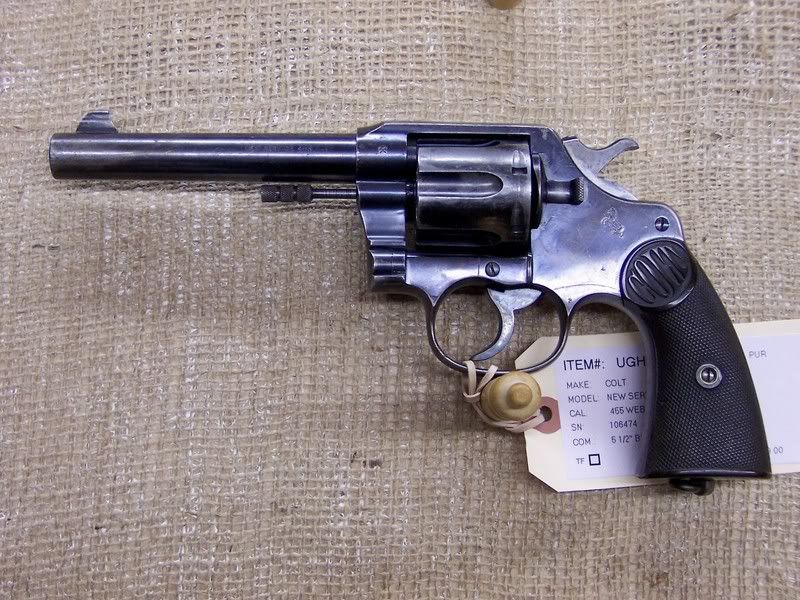 This is a Colt New Service revolver, made in .455 Webley calibre and issued to British troops in WW1. I've never actually seen a picture that captures the size and bulk of the Colt New Service - they are big, big guns. Not so much in length, but in heft. Although the Smith & Wesson Hand Ejector is a technologically superior gun (a situation which, frankly, was true in the 1870s and never really changed), the Colt was the more popular of the two in British service because of its sheer indestructibility. |
|
#3
|
|||
|
|||
|
Now some long guns.
 I'm sure this needs no introduction - a Winchester M97 Trench Shotgun (officially referred to as an "M97 riot shotgun with heat shield and bayonet adaptor"). This is not a Norinco, but rather a genuine Winchester-made US Army trench gun. This is actually a WWII production gun, with the takedown frame and parkerised heat shield. It's definately used, but in great mechanical shape and with all the markings intact. Looks absolutely wicked with a 16" M1917 bayonet on the end of it. 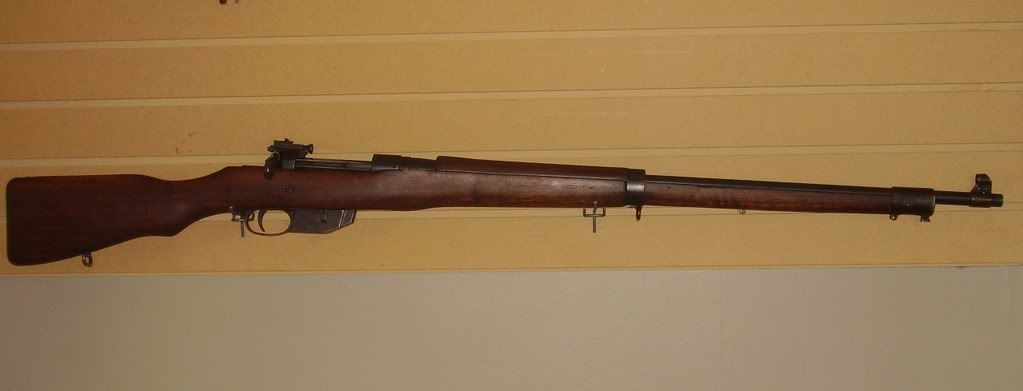 This is a Canadian Ross Mk.III rifle, as used by CEF troops during the first half of WWI. The Ross introduced by Canada after the Boer War, during which the British had refused to supply us with enough of the new Lee-Enfields and we decided to go our own way. Unfortunately, the Ross was much better suited to use as a target rifle and proved a disaster in service, proving finnicky and unreliable in the trenches using wartime ammo. It was replaced in service with the Lee-Enfield and relegated to use in training and by snipers, who loved it for its reknowned accuracy. 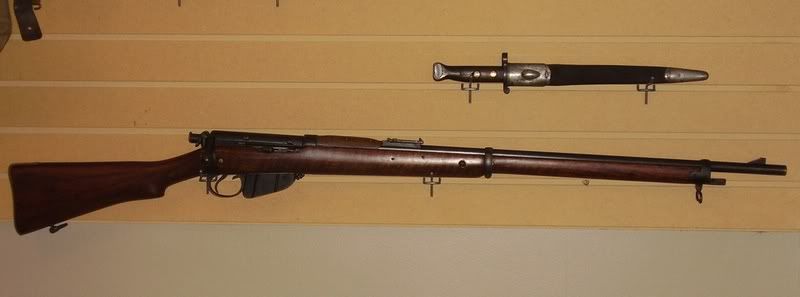 Speaking of which, this is a Boer War era Lee-Enfield Mk.I*, this one made by Birmingham Small Arms in 1896. This is actually one of about 1000 purchased by Canada before the Brits refused to sell us more, although given that its in nearly mint condition its unlikely that it actually went to South Africa. Also pictured is the extremely hard to find P88 bayonet, complete with original scabbard.  This a French Lebel mle 1886/93, made by St. Etienne in 1893 and rearsenalled by Chattelerault in 1934, so it was used by French troops in both world wars. The Lebel was the first modern rifle, ring a small-caliber smokeless powder cartridge, although it used an 8-round tube magazine under the barrel which necessitated loading it one round at a time. It provoked an arms race when it was introduced, so that by the turn of the century every major and most minor powers had something similar. |
|
#4
|
||||
|
||||
|
Wow! That is one HELL of an impressive collection! An actual WWII-era Winchester?
|
|
#5
|
||||
|
||||
|
wow, a trench gun...that's impressive
__________________
 "There's a fine line between not listening and not caring...I like to think I walk that line everyday of my life." Blessed be the LORD, my rock, Who trains my hands for war, And my fingers for battle Psalm 144:1 It is always wrong to use force, unless it is more wrong not to. |
|
#6
|
|||
|
|||
|
Thanks guys. The Trench Gun is a recent addition, got it last month.
 This is one of my favorites, a Lee-Enfield Royal Irish Constabulary carbine, one of about 1100 converted from Lee-Metford carbines in 1904 (the other 9000 done from Lee-Enfield cavalry carbines). These were used by the Royal Irish Constabulary during the Irish War of Independence from 1919-1921. This photo is gonig to be appearing in an article by Paul Scarlata in an upcoming issue of Shotgun News. Again, with the hard to find P88 bayonet. 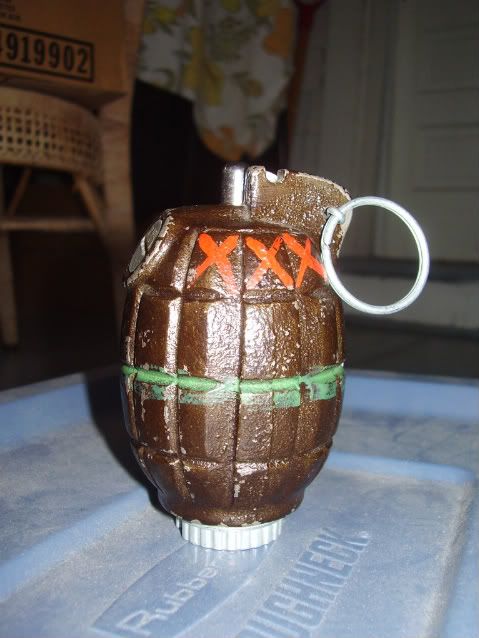 This is another recent addition, a 1944 dated British No.36 Mk.I Mills Bomb - no fuze or filler, of course, but everything else is there and original. The green band and red Xs indicate are the period British indicator for high explosive - this is a real fragmentation grenade, not a trainer. Not many of these survived the war, for obvious reasons.  Here's a pair of Austrian rifles, both of which use straight pull bolts. The top rifle is a Mannlicher M95/31, built by Steyr. These were the main Austro-Hungarian rifle of WW1. This one ended up in Austrian hands after the Habsburg empire was dissolved, and was converted to the more-powerful 8 x 56mm cartridge in 1931. The bottom one is a Mannlicher M88/95. The M88 was the previous model of Mannlicher, using a much weaker (but smoother) bolt design. This one is extremely rare in that it's been upgraded with M95 pattern sights - Paul Scarlata's book on Mannlichers (currently the definitive source) only includes one illustration and no photos. This one is still in the original 8 x 50mm chambering.  This is a Finnish Mosin-Nagant M/24 Civil Guard Rifle (nicknamed the "Lotta Svaard" after the women's auxiliaries who raised funds for them). Finnish Mosin-Nagants are actually built on rifles captured from the Russians and improved into entirely new models. The M/24 was built exclusively for the Civil Guard, who are best compared to a non government run version of the US National Guard. This one was issued in the Helsinki district, and used on the front lines when the Guard was called up during the 1939-1940 Winter War. Interestingly, unlike the vast majority, this has no regular army markings from when the Civil Guard was disbanded in 1945 in accordance with the peace treaty with the Soviets - suggesting it's owner stuck it in a barn, waiting for another Soviet invasion. |
 |
|
|